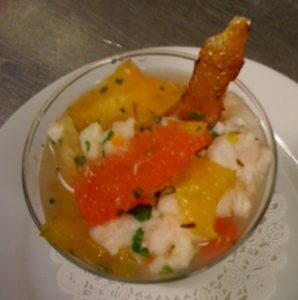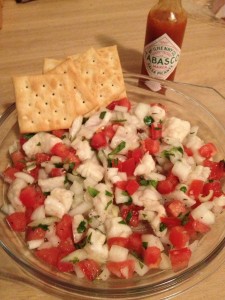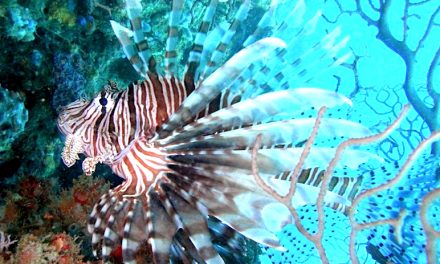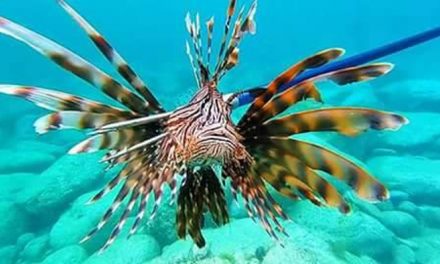There has been a lot of talk lately about eating lionfish; most of us who have had seafood and love fresh fish describe them as, “Delicious!” but when we talk about lionfish and how much we enjoy eating lionfish with people who have never tried it, the obvious question inevitably comes,
“What does lionfish taste like? Is it good to eat, really?”
 Great question! How does one exactly describe what anything tastes like, really, except to compare it to something similar that the person to whom we are speaking has experience tasting? A delicate white fish like this will readily accept the flavors and methods with which it is prepared! I like to describe lionfish as a quality canvas that readily accepts paint – the brighter the canvas, the more vivid the colors present themselves. However in reality, my usual answer goes something like this:
Great question! How does one exactly describe what anything tastes like, really, except to compare it to something similar that the person to whom we are speaking has experience tasting? A delicate white fish like this will readily accept the flavors and methods with which it is prepared! I like to describe lionfish as a quality canvas that readily accepts paint – the brighter the canvas, the more vivid the colors present themselves. However in reality, my usual answer goes something like this:
Lionfish is a white flaky fish, firmer in texture than halibut, no “red line” with a flavor profile somewhere between a thin grouper fillet and mahi mahi (dolphinfish or dorado depending upon where you live) with a touch of butter.
Yes, really.
After refining my description now over the course of several years, I think I’ve nailed down my own personal opinion. Just to be certain, I ate lionfish sashimi (thinly sliced raw fish) prior to sitting down to pen this article; I’m lucky that there is a plentiful supply of lionfish here in Panama and I only need a dive or two to fill my freezer, though I am mindful that their mere presence here is an unfolding tragedy. Still, I offer my description with the full understanding that palates and a sense of taste differ widely among us all. Other people are going to have a difference of opinion and may decide for themselves that lionfish tastes a lot like lobster!
 Who’s right, who’s wrong and what’s the point of writing an article about what lionfish taste like if we’ve established that taste is difficult, if not impossible, to describe and varies widely from person to person?
Who’s right, who’s wrong and what’s the point of writing an article about what lionfish taste like if we’ve established that taste is difficult, if not impossible, to describe and varies widely from person to person?
Quite frankly, I am writing this article for the skeptics.
The adventurous eaters will try lionfish if given the chance and a decent recommendation. It’s the comments from the skeptics I’ve read during this uptick of exposure that lionfish in cuisine has been getting. The most recent naysayer posted this comment exactly:
“I wonder if lionfish is really all that good seeing how people like you ascribe such magical flavors to it. It seems a bit disingenuous; contrived for the purposes of advancing your cause.”
Wow. While the consumption of lionfish is certainly a cornerstone of our foundational philosophy, I’d still be hard-pressed to put my name to anything I didn’t feel was honest… especially food! Standing a moment in their shoes though, I see how the simple (but genius) reef conservation catch phrase, “Eat ’em to beat ’em.” could be dismissed as folly, which got me thinking that it would be a much more powerful statement to the skeptics just to offer up a collection of uncensored opinions of the many people who do not have some nefarious motive to tell the world what lionfish truly taste like… “Why not ask many people what they thought for this article, too?”
I put this question out to the lionfish hunting social networks and received a nice variety of responses, none that I would describe as negative at all and, rather surprisingly, no trolls calling us “stupid fish-killers with small man-parts” either,
“How would you personally describe what lionfish tastes like?”
Here is a sampling of responses we’ve received within a relatively short amount of time, with no editing:
“The chicken of the sea. Tons of white meat. Very little spines.”
“I always describe it as a white flaky fish, firm in texture, no red line with flavor somewhere between a thin grouper filet and Mahi.”
“Depends on the way I prepare the lionfish. But when I eat it after a catch like sushi I think Scott describes it very well.”
“I. HAD THE PLEASURE OF TASTING LIONFISH THE 21 OF NOVEMBER THE DAY AFTER I ARRIVED IN AKUMAL after being away for 17 YRS..THE. FIRST MEAL WAS a FILET. FRESHLY CLEANED AND PLACE ED ON A FLAT GRILL . IT WAD PLATED ALONE WITH SOME FRESH TY SLAW. THE FISH WAS SURPRISING FIRM FOR A THIN. FILET. SURPRISINGLY. TASTEY. NOT FISHEY AT ALL IT WAS A PLEASURE TO EAT AND T E TY SLAW WAS A PERFECT ADDITION. SECOND MEAL. WAS SERVED IN A LIGHT BEER BATTER. THAT WAS THIN IT COMPLIMENTED THE FISH. WITH. F.F. THE NEXT WAS PAN SAUTEED WITH. TEQUILA AND SOMETHING ELSE. THIS WAS GREAT AND MY FAVORITE. ALONG. WITH THE FRESH TORTILLA LIONFISH TACO WITH HOMADE. PABLANO. TAMARIND SAUCE ON THE SIDR. AT GYNN”AK. RESTAURANT IN AKUMAL. MX. I STAYED. TWO MOUTH S. AND LOST. TWENTY LBS. ENJOY THE FISH AND THE TOWN. I WILL BE BACK. I HAVE ALSO ARRANGED FOR A SHIPMENT OF LIONFISH. TO CHICAGO FOR MY B DAY IN AUGUST. WITH THE. LIONFISH HUNTER CHEF GYNNA TO COME UP AND PREPARE. THE FOOF”
“Grouper.”
“Mild, moist, buttery and very tender (definitely not the firmest of white fleshed fin fish). In a well-made ceviche, the Lionfish melts in your mouth, while the ‘butteriness’ balances well with the lime juice.”
“Tender white fish”
“In Ceviche it is rather firm and tastes like a cross between lobster and shrimp. It is not “fishy.” From the grill it is a lot like grouper. Yumm. . . .”
“I have only had it in a crepe, but was delicious. Not mushy and instead was meaty.”
“Tastes exactly of what they eat! shrimp, lobster, fish, crab… tasty :d”
“Like chicken. . .doesn’t everything taste like chicken?”
“It’s a mild white flaky fish cross between a real mild grouper and real mild snapper. Besides Scorpion fish it’s the second best tasting fish in the sea”
“SE Florida Lions taste very similar to Hogfish, but we prefer them in my home. Thick dense white meat. Flaky, and LOADED with protein. The filets are much thicker that that of a similar length Hog Fish. We typically filet them in the Dolphin/Mahi manner and do a Cuban style light pan fry. They are the greenest of the green to consume in the Atlantic Basin.”
“Tastes like lobster. At least, the texture is lobster-like.”
“I’m not even sure that lionfish is kosher!”
As a hard-core business guy, I think that the economic underpinnings of food can also be used to interpret to how good food tastes. First, lionfish is considered a delicacy much the world over; it is a food-fish in its natural range of the Indo-Pacific Ocean. A close friend of mine who is on the front lines of the lionfish fight here in Panama recently relayed that lionfish is being purchased for $90 a pound. Secondly, I know that a sushi restaurant in Colorado recently paid $500 for a single two pound whole lionfish to feature in a culinary event that included additional examples of lionfish sushi as well. Lastly, a chef in a Charleston, South Carolina restaurant said in an email exchange, “Our guests love it, and it sells out every time.” In fact, almost all of the restaurant representatives I’ve talked to in the last week while compiling our list of restaurants that serve lionfish have said the same thing; the demand for lionfish is certainly outstripping the supply. If lionfish tasted bad, or even mediocre, the demand for lionfish would be altogether nonexistent – there are some great tasting fish in the sea!
I would certainly say that we are really fortunate that lionfish tastes good enough that scuba divers and freedivers think they are worth the substantial effort and personal cost to catch and put on a plate! Without their considerable efforts the lionfish population in the Atlantic Basin would already be too overwhelming. Ultimately, the challenge to the real commercialization of lionfish is NOT taste, texture or availability. The significant barrier between tasty lionfish fillets and North American dinner tables is simply production – a topic we’ll explore at length another time.
 Lionfish is delicious and I urge you to try it for yourself when the opportunity presents itself.
Lionfish is delicious and I urge you to try it for yourself when the opportunity presents itself.
Divers: Target lionfish on your next hunting trip and leave the snapper, grouper and lobsters alone for a dive or two. CULLING LIONFISH IS THE VERY BEST THING YOU COULD POSSIBLY DO FOR THE DIVE SITE, even if you do not plan to eat them (just make sure they are dead). If you are an inexperienced underwater hunter then find a dive shop, local divemaster or friend who is an experienced lionfish hunter. Learn to harvest them without doing damage to the environment (they are the easiest fish in the sea to target with a spear – but don’t tell Jon “O for 6” Youngman that) and then how to safely handle and prepare the lionfish to eat without catching yourself on a spine!
We feature many great recipes on our website to give you some excellent serving ideas! Anything you can do with snapper, mahi mahi, grouper, drum, porgy, sea bass, flounder, etc. you can do with lionfish. Personally, if I didn’t eat lionfish sashimi or ceviche, two ultra-simple ways to prepare the fish, I’d choose to sauté lionfish strips in a pan with EVOO (extra virgin olive oil), sea salt and some cracked black pepper then serve them up with lime wedges and ice-cold beer.
 Diners: Do you have a favorite seafood restaurant? Make it a point to ask for lionfish, even though you know it is not on the menu – seriously. Tell them that you want to try lionfish and maybe it will be a featured appetizer or special plate next time you return! To begin to even put a dent in the exploding lionfish population that threatens the very existence of our reefs and local fish populations, we essentially need to over-fish them. The only way that will happen is if there is a demonstrable demand for them as a popular food choice (or we could just foment the belief that eating lionfish spines are good for reproductive virility and sexual potency to the same cultures of people driving rhinos, tigers and sharks into extinction for various body parts based on these very same misbeliefs and myths).
Diners: Do you have a favorite seafood restaurant? Make it a point to ask for lionfish, even though you know it is not on the menu – seriously. Tell them that you want to try lionfish and maybe it will be a featured appetizer or special plate next time you return! To begin to even put a dent in the exploding lionfish population that threatens the very existence of our reefs and local fish populations, we essentially need to over-fish them. The only way that will happen is if there is a demonstrable demand for them as a popular food choice (or we could just foment the belief that eating lionfish spines are good for reproductive virility and sexual potency to the same cultures of people driving rhinos, tigers and sharks into extinction for various body parts based on these very same misbeliefs and myths).
Better yet, support the restaurants that support conservation by putting lionfish on their menus! If you live or are vacationing in an area where one of the restaurants that serve lionfish we have listed is located GO THERE AND ORDER LIONFISH! (Tell them we sent you.)
OK, back to the skeptics…
It is true that lionfish are here to stay and we’ll never completely eradicate them, but as our friends from the Caribbean Oceanic Restoration and Education Foundation (CORE) like to say, “Trash is also a problem but it’s not like you are going to do nothing about it.“ Trash will continue to accumulate but quality of life significantly improves when it is hauled away and managed properly.
The lionfish problem is a lot like that, too, but I’d never enjoy eating garbage with soy sauce and wasabi.
Let’s keep the conversation going! What do YOU think lionfish tastes like? Do you like to eat lionfish? We want to hear from you, leave your comments below!







We are in the seafood restaurant business,I saw this on the shark tank tonight where they were trying to introduce the L F into the market place.I need more info.
I try the lionfish, an boy i tell u it was delicious
Lionfish? Lionfish? Lionfish!!! That’s all I eat! Better than grouper or sea bass! Save the reef – eat a lionfish!
I live and fish in Rhode Island and what a surprise I was in for when diving for quahogs and I netted this mottled orange beautiful fish that looked like a fish I seen in an aquarium. In fact I didn’t know what the hell it was but the guy at a bait shop nearby did. He’d never seen one here in Rhode Island and called the University of Rhode Island oceanographic institute and the guy showed up a few hours later. He looked a bit shocked but confirmed it was in fact a lion fish, 14″ inches long. I was afraid to eat it but now that I know they are good to eat I will be keeping my eyes open. I only seen this one fish so far but it sure stuck out like a sore thumb and was really easy to net. I’m shocked that they are in this colder water up here.
Thanks, Billy, for the comment. It is always fascinating to hear about the lionfish farther north than Virginia as the reports seem rare.
Fortunately most of the lionfish in the northern ends of their invasive habitat will die when the cold water gets below approximately 53 degrees; Rhode Island seems to be the farthest north we have heard of them in the past. Capture, kill and eat any lionfish that you may come across.
Scott
Great site. I am no skeptic, I’d love to eat it, but as far as I can tell, it’s basically unavailable to your average US consumer. I found one source online that wanted $39.99 for one fish, and while we might actually order one for a fling, that’s just not going to catch on.
Some entrepreneur needs to jump on this!
Is it Kosher?
FISH
Fish that have fins and scales are kosher. Fish that only have fins are not kosher. Of the four types of scales, clenoid, cycloid, ganoid and placoid, only clenoid and cycloid scales are valid according to the Torah. Gandoid is the type found on sturgeon and placoid is found on shark. There is no prohibition against eating fish blood, other than the fact that people may think that a person is eating prohibited blood, and ritual slaughter is not required.
Size and appearance of Lionfish
The largest scientifically measured Volitans Lionfish was 38 cm / 15 in.
The body is covered in cycloid scales and decorated with reddish, golden brown or black bands over a pale yellow or creamy white base colour. The dorsal and anal fins sport dark rows of spots. In adult fish, you can usually see white spots along the lateral line. The exact colours of the Volitans Lionfish will chiefly depend on the surrounding environment. Coastal dwellers tend to be darker and specimens found in estuaries can be almost black.
The pectoral and dorsal fins of this species are very long, and most specimens have a tentacle above both eyes. The size and shape of the tentacle varies from individual to individual and is usually longer in juveniles and more similar to a leaf in adult fish. There is a body ridge across the cheek, and flaps will partially cover both eyes and nose.
Volitans Lionfish distinguishes itself from other members of the family Scorpaenidae by having 13 venomous dorsal spines instead of 12. It is also equipped with 14 feather-like pectoral rays. The anal fin has 3 spines and 6-7 rays.
Volitans Lionfish can easily be confused with the Spotfin Lionfish (Pterois antennata), but you can tell them apart by looking at the pectoral fins. On a Volitans Lionfish, the pectoral fins will be pointier and adorned with variable spots and bands. On a Spotfin Lionfish, the pectoral fins are rounder and their colouration varies from white to golden. You can also them them apart by counting the pectoral rays; Volitans Lionfish has 14-16 rays while the Spotfin Lionfish has 16-17 rays. The scales are another important difference. As mentioned above, the body of Volitans Lionfish is covered in cycloid (rounded) scales. In the Spotfin Lionfish, the scales are mostly ctenoid, i.e. their margins are toothed like a comb.
Thanks for posting this! I was JUST WONDERING about this and was happy to see someone answer my silent question! I have been shifting in the direction of kosher foods. Thank you.
Kosher. Cycloid scales. Learned this firsthand only 2 years ago and feel horrible about those scores that I killed and disposed. Now all 4 my kosher children eat sashimi and ceviche of lionfish when we go to Cozumel
I am looking forward to trying my first lion fish today! I will try and remember to come back and let everyone know what I think. I am so excited.
To preface my comment, I consider myself an adventurous eater. I was all prepared to order fried oysters at The Bay restaurant in Santa Rosa Beach FL until we saw lion fish on the daily special menu. After ordering we were wondering what it taste like. We jokingly said the waitress would tell us “it taste like chicken”. Asking Mr Google “what does lion fish taste like”, turned me on to this site.
So, here is my opinion. The presentation was great, a whole fish, fried with head, spines and all sitting up on the plate. It reminded me of the flying catfish I had in Little Rock Arkansas. These are the only two times I have ever seen fish served “standing” versus laying on its side. Do NOT misinterpret this statement. The presentation was more impressive than the taste. That isn’t a negative comment. It was very good and was cooked perfectly. If you like fish, you will like this too. It was very white, mild and tasty. Sorry I can not compare it to other fish. If pressed I may compare it to a mild lake fish like crappy. I like all fish that I’ve had. I look forward to finding lions at other locations prepared in other ways like some of the comments described. Happy lion eating.
I ate lionfish for the first time last week while holidaying in Puerto Morales, Mex. I knew nothing about it and just liked the sound of the way it was prepared. It was absolutely delicious and I shall definitely seek it out again when possible. Now I know it is a menace so there’s even more reason to eat it.
Kosher. Cycloid scales. Learned this firsthand only 2 years ago and feel horrible about those scores that I killed and disposed. Now all 4 my kosher children eat sashimi and ceviche of lionfish when we go to Cozumel
Fillet, which is associated with seafood, is spelled with 2 ‘L’s. Filet is associated with meat.
Had Lionfish in the Keys – its amazing. Closest description I can ascribe is sort of a fish shape Blue Crab. I primarily had them whole fried and fairly small.
Carrying the Blue Crab theme, I would love to get a bowl of like 6 of them and a bucket of beer –